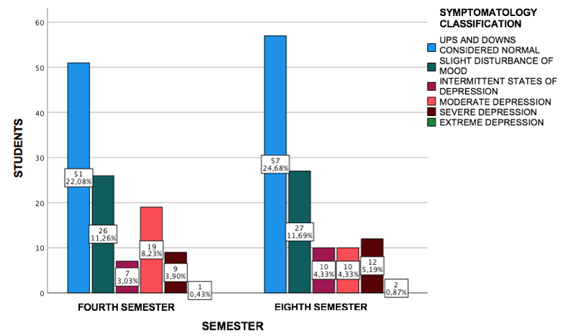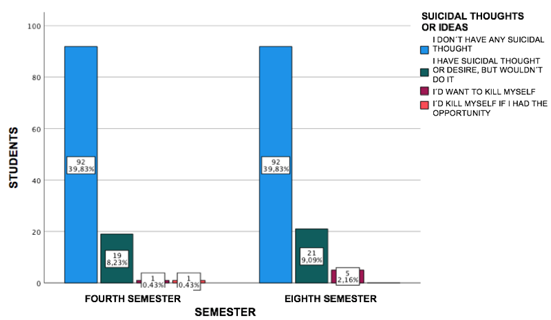International Journal of
eISSN: 2577-8269


Research Article Volume 7 Issue 3
1Full Time Professor, Dr. Manuel Velasco Suárez School of Human Medicine, Campus II, UNACH
2Medical Intern of Social Service, Dr. Manuel Velasco Suárez School of Human Medicine, Campus II, UNACH, Mexico
3Medical Surgeon, Faculty of Human Medicine Dr. Manuel Velasco Suárez, Campus II, UNACH, Mexico
Correspondence: Mandujano Trujillo Zally Patricia, Dr. Manuel Velasco Suárez School of Human Medicine, Campus II, UNACH, Tuxtla Gutiérrez, Chiapas, Mexico, Tel +52 961 603 6475
Received: May 16, 2023 | Published: May 30, 2023
Citation: Trujillo ZPM, Pirrón TAJ, Ochoa SRR, et al. Depressive symptomatology in medical students in Chiapas, Mexico. Int J Fam Commun Med. 2023;7(3):78-81. DOI: 10.15406/ijfcm.2023.07.00316
Depression is a common mental disorder that can significantly affect medical education students. Intense academic load, high expectations and stress associated with medical training can contribute to the development of depression, which has an impact on the emotional and mental well-being of students, fundamental for their academic success and future medical practice.
Objective: To determine the prevalence of depressive symptoms in medical students of Campus II of the Autonomous University of Chiapas.
Method: The type of study was descriptive, cross-sectional and prospective, the sample of 231 students in the period January - June 2020. After informed consent, the Beck Depression Inventory was applied for depressive diagnosis. It was classified according to symptomatology as mild, moderate and severe.
Results: It was determined that 8.23% in the fourth semester presented moderate symptomatology and 5.19% in the eighth semester had severe symptomatology. In the fourth semester 8.23% and 9.09% of the eighth semester have had suicidal thoughts. Also 67.96% of both semesters referred lack of concentration, which affects students' academic performance.
Conclusions: With the results obtained it is evident that almost one third of the population studied presents some depressive symptom and one fifth, suicidal ideation, so it is necessary to address depression, to promote a healthy learning environment and support the general welfare of students.
Keywords: depression, beck depression inventory, medical students, symptomatology
Depression is the leading cause of health problems and disability worldwide, with an estimated 3.8% of the population experiencing depression, including 5% of adults (4% among men and 6% among women) and 5.7% of adults over 60 years of age. Worldwide, approximately 280 million people suffer from depression. Depression is approximately 50% more common among women than among men. More than 700,000 people commit suicide each year. Suicide is the fourth leading cause of death in the 15-29 age group.1 Depression presents as a set of symptoms of affective predominance, cognitive, volitional and somatic symptoms.2 In most medical educational institutions around the world, the level of demand for learning extensive knowledge and mastering diagnostic and surgical treatment techniques cause medical students to be exposed to levels of anxiety and stress. It is documented that medical students exhibit high levels of stress and mental disorders, e.g., depression. When the adverse effects of anxiety and depression on academic outcomes were explored in them, it was found that those with elevated levels of these stressors, reported low academic performance. In many studies conducted on depression and other mental disorders in medical students, some of the main factors that affect the mental health of this population have been taken into consideration, such as: (AEMPPI Ecuador)3
A study was conducted in medical students from 43 countries, where depression was found in 27.2% and suicidal ideation in 11.1% during their training,4 these are subjected to stress by the academic demands and highly competitive environment, in the development of the learning process. In a study conducted on 732 first year medical students of the Holguin Faculty of Medical Sciences "Mariana Grajales Coello" in Cuba, it was detected that more than half of the students had an excessive level of stress and medium depression, predominantly in the female sex. In a study conducted at the Autonomous Metropolitan University of Mexico City, it was concluded that medical students showed higher prevalence of anxiety, depression and suicidal behavior than students in other careers, and that those in the last grade showed higher prevalence than those in the first grade. Gender was a variable that influenced more among students of other careers, but less in medicine. In Mexico, the Instituto Tecnológico y de Estudios Superiores de Monterrey, Campus Guadalajara, during the period of 2020 conducted a descriptive and cross-sectional study, applying the Goldberg General Health Questionnaire to a sample of 177 medical students, found 35.8% symptoms of anxiety and 8% of depression.
A descriptive, cross-sectional and prospective research was conducted. The sample consisted of 231 students of the Faculty of Human Medicine, Campus II of the Autonomous University of Chiapas (FMH-CII), who were in the fourth and eighth semester of the January-June 2020 school year. The sample consisted of 93 males, 131 females and 7 students who did not specify gender, aged 18 to 23 years. The Beck Depression Inventory was applied, which is a self-assessment scale that detects the presence of depressive symptoms and quantifies their severity. It consists of 21 items, in each of which the person must choose, among four alternatives ordered from least to most severe, the statement that best describes his or her state during the last two weeks; this is rated from 0 to 3, with a total of 63 points. It is classified according to its severity in 0-13, no depression; 14-19, mild depression; 20-28, moderate depression; and 29-63, severe depression.5 The survey was given to the students in each module for self-application, requesting voluntary collaboration, signature of informed consent and assuring anonymity and confidentiality.
In Figure 1, it is observed that 8.23% (19) of the students in the fourth semester presented moderate symptomatology and 5.19% (12) of the eighth semester was severe. In fourth semester 8.23% (19) and 9.09% (21) of the eighth semester have had suicidal thoughts. Also 41.99% (97) of the students in both semesters reported lack of concentration, which affects their academic performance, a situation that is explained by the application of the parameters suggested by the creators of the Beck Depression Inventory, from which it was observed that 30.31% (70) of the total sample presented some degree of depression.
Figure 2 shows that "suicidal thought or desire" was 17.32% (40), 8.23% (19) of fourth semester students and 9.09% (21) of eighth semester students, among the students with this idea, have had the desire to commit suicide but would not carry out the action. 2.59% (6) of the students answered "I would want to kill myself"; although the item "I would kill myself if I had the opportunity" was only 0.43% (1).
Of the female respondents 45.02% (104) have not had any suicidal thoughts, 10.39% (24) of them have had the thought but would not do it, however 1.30% (3) of women would like to kill themselves but none answered that "They would kill themselves if they had the chance". As for the male respondents 33.33% (77) of them have not had any suicidal thoughts, 5.63% (13) have had the thought of killing themselves but would not do it, 0.87% (2) answered that they would want to kill themselves. The results obtained in the study regarding suicidal ideation were 20.35% (47), of which 11.69% (27) were women, 6.93% (16) were men and 1.73% (4) did not indicate their sex Figure 3.
In Figure 4, we observe that the prevalence of "Feeling of failure" was found in 18.18% (42) of the eighth semester students and 20.79% (48) of the fourth semester students. In Figure 5 it is observed in 21.21% (49) of the fourth and 20.78% (48) of the eighth semester that "They do not concentrate as well as usual"; 12.12% (28) students of the fourth semester and 10.39% (24) of the eighth semester "It is difficult for them to keep their mind on something for a long time; and both semesters, 3.46% (8) answered "They do not concentrate on anything".

Figure 1 Depressive symptomatology in students.
Source: Database obtained from Beck survey. FMH-CII, 2020.

Figure 2 Suicidal thoughts or ideas in students.
Source: Database obtained from Beck survey. FMH-CII, 2020.
In a study conducted in students of the Benemérita Universidad Autónoma de Puebla, it was observed that the percentage of students with probable major depressive syndrome is 31.72%, which according to the items used assessable balanced in percentages; while in this study lower figures were found (10.39%). At the Autonomous University of Baja California in 2018, they found that 20.2% (40) presented severe or moderately severe depressive symptoms and 7.9% (16) severe or moderately severe, results similar to those obtained in the present study. With respect to "Suicidal thought or desire" it was found to be 17.32%, a result that differs from that performed at the National University of Asuncion (2018), where 54.9% was reported, and at the Benemérita Universidad Autónoma de Puebla 12.7%. In a study conducted in medical students at the National Autonomous University of Mexico, a general prevalence of depressive symptomatology of 26.8% and suicidal behavior of 39.6% was found,6 while in the present study similar results were found in depressive symptomatology of 30.31% and lower in suicidal ideation, 20.35%. In the school failure of students, external factors such as lack of motivation and interest in the career they study, low motivation in the development of teaching activities, studying alone, insufficient time devoted to independent study, and the use of reading and memorization as the only study technique are identified.7 It was observed in the present study that the prevalence of the "Feeling of failure" was 18.18% (42) of the eighth semester students and 20.79% (48) of the fourth semester students. No previous studies were found regarding mental concentration in medical students, so it was not possible to make a comparison of the results obtained.8–20
The results make it evident that suicidal ideation is a frequent phenomenon in medical students. Although these students self-medicate and lie about their depressive state to the educational institutions to which they belong, emphasis should be placed on knowing how to identify those cases in which suicidal potential is present in order to act and provide them with health care (medical, psychological, moral and social). The alteration of the emotional state of students can lead to difficulties in mental and work concentration in the short and long term, giving rise to one of the most feared endings: suicide. The aim of this is for educational institutions to invest in the mental education of their students, thus reinforcing the gap between the emotional, social and psychological burden that a degree such as medicine entails. Students should be motivated to question their mental health as a prevention of a depressive condition that leads to the end of life, so it is important to promote self-care of physical and mental health, from the beginning of their academic training. Therefore, it is essential that the university community join efforts in the creation and implementation of prevention and early detection programs, through the Beck Depression Inventory from before starting the first semester and throughout the course of their university stay, with the primary objective of identifying alterations in mood, self-destructive behaviors, suicidal thoughts, feelings of sadness, and implement long-range support strategies to keep the student motivated and able to meet the challenges they face, as their academic and professional life progresses. It is necessary to preserve the mental health of medical students, which will be reflected in the well-being of society in general.
None.
The author states that none exists.

©2023 Trujillo, et al. This is an open access article distributed under the terms of the, which permits unrestricted use, distribution, and build upon your work non-commercially.